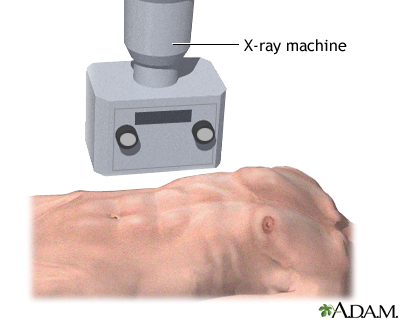Health Library
X-ray
Radiography
X-rays are a type of electromagnetic radiation, just like visible light.
An x-ray machine sends individual x-ray waves through the body. The images are recorded on a computer or film.
- Structures that are dense (such as bone) will block most of the x-ray waves, and will appear white.
- Metal and contrast media (special dye used to highlight areas of the body) will also appear white.
- Structures containing air will be black, and muscle, fat, and fluid will appear as shades of gray.
Images


I Would Like to Learn About:
How the Test is Performed
The test is done in a hospital radiology department or in the health care provider's office. How you are positioned depends on the type of x-ray being done. Several different x-ray views may be needed.
You need to stay still when you are having an x-ray. Motion can cause blurry images. You may be asked to hold your breath or not move for a second or two when the image is being taken.
The following are common types of x-rays:
- Abdominal x-ray
- Barium x-ray
- Bone x-ray
- Chest x-ray
- Dental x-ray
- Extremity x-ray
- Hand x-ray
- Joint x-ray
- Lumbosacral spine x-ray
- Neck x-ray
- Pelvis x-ray
- Sinus x-ray
- Skull x-ray
- Thoracic spine x-ray
- Upper GI and small bowel series
- X-ray of the skeleton
How to Prepare for the Test
Before the x-ray, tell your health care team if you are pregnant, may be pregnant, or if you have an IUD inserted.
You will need to remove all jewelry. Metal can cause unclear images. You may need to wear a hospital gown.
How the Test will Feel
X-rays are painless. Some body positions needed during an x-ray may be uncomfortable for a short time.
Risks
X-rays are monitored and regulated so you get the minimum amount of radiation exposure needed to produce the image.
For most x-rays, your risk for cancer, or if you are pregnant, the risk for birth defects in your unborn baby is very low. Most experts feel that the benefits of appropriate x-ray imaging greatly outweigh any risks.
Young children and babies in the womb are more sensitive to the risks of x-rays. Tell your provider if you think you might be pregnant.
Related Information
VenogramReferences
Mettler FA. Introduction: an approach to image interpretation. In: Mettler FA, ed. Essentials of Radiology. 4th ed. Philadelphia, PA: Elsevier; 2019:chap 1.
Rodney WM, Rodney JRM, Arnold KMR. Principles of x-ray interpretation. In: Fowler GC, ed. Pfenninger and Fowler's Procedures for Primary Care. 4th ed. Philadelphia, PA: Elsevier; 2020:chap 235.
BACK TO TOPReview Date: 7/25/2022
Reviewed By: Linda J. Vorvick, MD, Clinical Professor, Department of Family Medicine, UW Medicine, School of Medicine, University of Washington, Seattle, WA. Also reviewed by David C. Dugdale, MD, Medical Director, Brenda Conaway, Editorial Director, and the A.D.A.M. Editorial team.
 | A.D.A.M., Inc. is accredited by URAC, for Health Content Provider (www.urac.org). URAC's accreditation program is an independent audit to verify that A.D.A.M. follows rigorous standards of quality and accountability. A.D.A.M. is among the first to achieve this important distinction for online health information and services. Learn more about A.D.A.M.'s editorial policy, editorial process and privacy policy. A.D.A.M. is also a founding member of Hi-Ethics. This site complies with the HONcode standard for trustworthy health information: verify here. |
The information provided herein should not be used during any medical emergency or for the diagnosis or treatment of any medical condition. A licensed medical professional should be consulted for diagnosis and treatment of any and all medical conditions. Links to other sites are provided for information only -- they do not constitute endorsements of those other sites. © 1997- 2023 A.D.A.M., a business unit of Ebix, Inc. Any duplication or distribution of the information contained herein is strictly prohibited.
